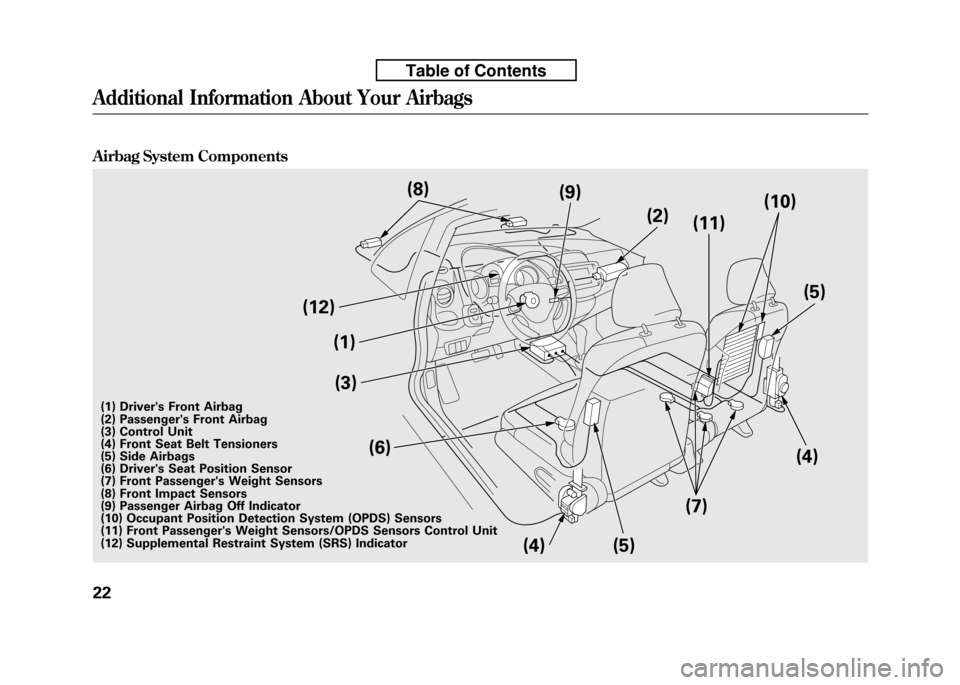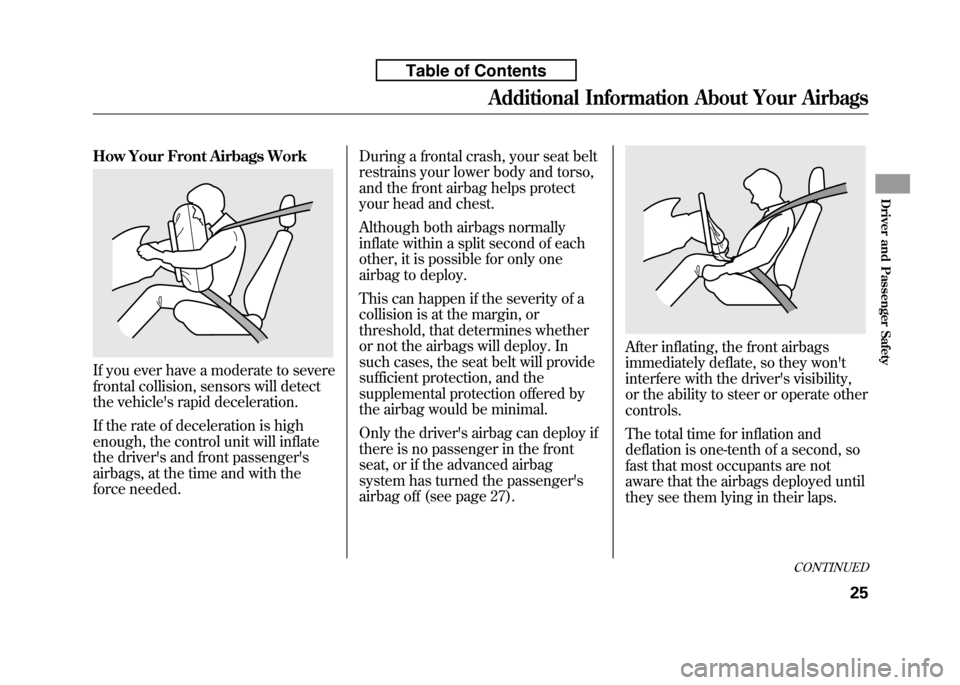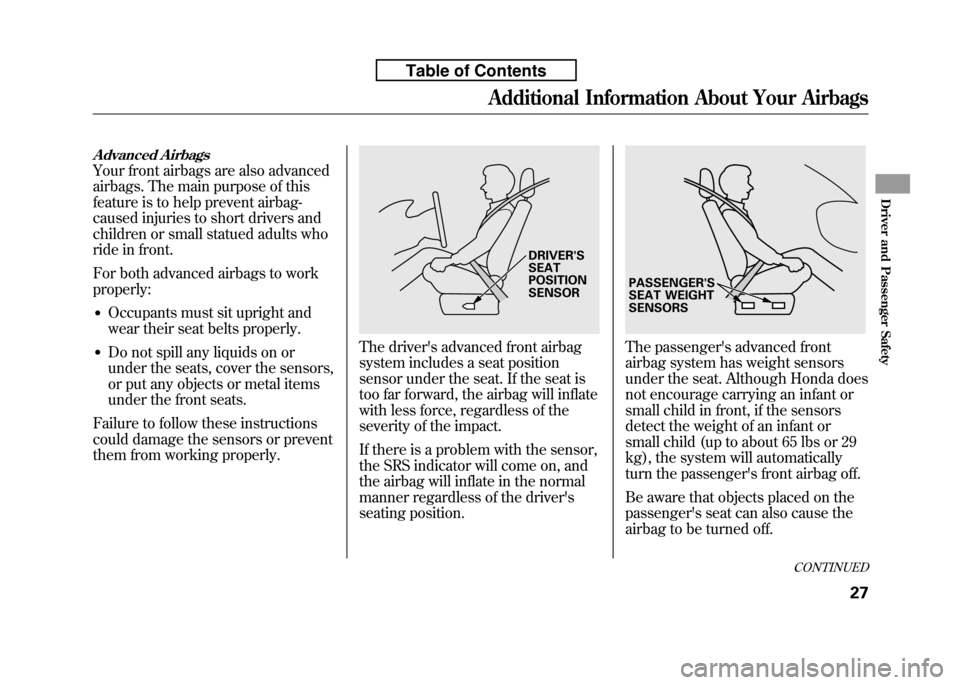sensor HONDA FIT 2010 2.G Owners Manual
[x] Cancel search | Manufacturer: HONDA, Model Year: 2010, Model line: FIT, Model: HONDA FIT 2010 2.GPages: 351, PDF Size: 5.67 MB
Page 8 of 351

R
Radiator Overheating.................301
Radio/Disc Sound System .........143
Radio Theft Protection ...............191
Readiness Codes ........................329
Rear Lights, Bulb Replacement ........................... 266
Rearview Mirror .........................101
Rear Window Defogger ................76
Rear Window Wiper and
Washer ..................................... 73
Recommended Shift Speeds .......218
Refueling .................................... 199
Reminder Indicators .....................60
Remote Audio Controls ..............189
Remote Transmitter .....................90
Replacement Information Dust and Pollen Filter .............268
Engine Oil and Filter ...............254
Fuses ...................................... 306
Light Bulbs ............................. 262
Schedule ................................. 251
Spark Plugs ............................. 318
Tires ....................................... 276Wiper Blades
..........................
269
Replacing Seat Belts After a
Crash ........................................ 20
Reporting Safety Defects (U.S. Vehicles) ................................ 334
Reserve Tank, Engine Coolant ............................ 202, 256
Restraint, Child ............................ 34
Reverse Gear Position ................221
Reverse Lockout ........................217
Rotation, Tire ............................. 276
S
Safety Belts .............................. 8, 18
Safety Defects, Reporting (U.S.
only) ....................................... 334
Safety Features .............................. 7
Airbags ................................. 9, 22
Door Locks .............................. 11
Head Restraints ........................13
Seat Belts ........................ 8, 14, 18
Seats & Seat-Backs ..............11, 12
Safety Labels, Location of .............54
Safety Messages ..........................iiiSeat Belts
................................. 8, 18
Additional Information .............18
Advice for Pregnant Women ....16
Automatic Seat Belt Tensioners ........................... 20
Cleaning .................................. 267
Detachable Anchor ..................99
Lap/Shoulder Belt ..............14, 19
Maintenance ............................ 20
Reminder Indicator and
Beeper ............................. 18, 60
System Components ................18
Use During Pregnancy .............16
Wearing a Lap/Shoulder Belt .................................. 14, 19
Seats ............................................ 93
Seats, Adjusting the .....................93
Seat Under Box .......................... 106
Security System .........................193
Security System Indicator ............66
Sensors
Driver's Seat Position Sensor ...27
Front Passenger's Weight
Sensors ................................ 27
Impact Sensors ...................22, 23
Serial Number ............................ 316
Index
VIII
Page 34 of 351

Seat Belt System Components
Your seat belt system includes lap/
shoulder belts in all seating positions.
The front seat belts are also equipped
with automatic seat belt tensioners.
This system uses the same sensors as
the front airbags to monitor whether
the front seat belts are latched or
unlatched, and how much weight is on
the front passenger's seat (see page27).
The seat belt system includes
an indicator on the instrument
panel and a beeper to remind you and
your passengers to fasten your seatbelts.
This system monitors the front seat
belts. If you turn the ignition switch to
the ON (II) position before your seat
belt is fastened, the beeper will sound
and the indicator will flash. If your seat
belt is not fastened before the beeper
stops, the indicator will stop flashing
but remain on. If a front passenger does not fasten
their seat belt, the indicator will
come on about 6 seconds after the
ignition switch is turned to the ON
(II) position.
If either the driver or a front
passenger does not fasten their seat
belt while driving, the beeper will
sound and the indicator will flash
again at regular intervals.
When no one is sitting in the front
passenger's seat, or a child or small
adult is riding there, the indicator
should not come on and the beeper
should not sound.
If the indicator comes on or the
beeper sounds when the driver's seat
belt is latched and there is no front
seat passenger and no items on the
front seat, something may be
interfering with the monitoring
system. Look for and remove:
● Any items under the front
passenger's seat.
● Any object(s) hanging on the seat
or in the seat-back pocket.
● Any object(s) touching the rear of
the seat-back.
If no obstructions are found, have
your vehicle checked by a dealer.
Additional Information About Your Seat Belts
18
Table of Contents
Page 38 of 351

Airbag System Components
(1)(3)
(6)
(12)
(4) (5)(11)
(4)
(7) (5)
(9)
(10)
(2)
(8)
(1) Driver's Front Airbag
(2) Passenger's Front Airbag
(3) Control Unit
(4) Front Seat Belt Tensioners
(5) Side Airbags
(6) Driver's Seat Position Sensor
(7) Front Passenger's Weight Sensors
(8) Front Impact Sensors
(9) Passenger Airbag Off Indicator
(10) Occupant Position Detection System (OPDS) Sensors
(11) Front Passenger's Weight Sensors/OPDS Sensors Control Unit
(12) Supplemental Restraint System (SRS) Indicator
Additional Information About Your Airbags
22
Table of Contents
Page 39 of 351

Your airbag system includes:● Two SRS (supplemental restraint
system) front airbags. The driver's
airbag is stored in the center of the
steering wheel; the front
passenger's airbag is stored in the
dashboard. Both are marked ‘‘SRS
AIRBAG ’’(see page 25).
● Two side airbags, one for the
driver and one for a front
passenger. The airbags are stored
in the outer edges of the seat-
backs. Both are marked ‘‘SIDE
AIRBAG ’’(see page 28).
● Two side curtain airbags, one for
each side of the vehicle. The
airbags are stored in the ceiling,
above the side windows. The front
and rear pillars are marked ‘‘SIDE
CURTAIN AIRBAG ’’(see page 30).
(14)
(15) (14)(15)
(13)
(13) Side Curtain Airbags
(14) Side Impact Sensors (First)
(15) Side Impact Sensors (Second)
CONTINUED
Additional Information About Your Airbags
23
Driver and Passenger Safety
Table of Contents
Page 40 of 351

●Automatic front seat belt
tensioners (see page 20).
● Sensors that can detect a moderate
to severe front impact or sideimpact.
● Sensors that can detect whether a
child is in the passenger's side
airbag path and signal the control
unit to turn the airbag off (see
page 29).
● Sensors that can detect whether
the driver's seat belt and the front
passenger's seat belt are latched or
unlatched (see page 18).
● A driver's seat position sensor that
monitors the distance of the seat
from the front airbag. If the seat is
too far forward, the airbag will
inflate with less force (see page27). ●
Weight sensors that monitor the
weight on the front passenger's
seat. If the weight is about 65 lbs
(29 kg) or less (the weight of an
infant or small child), the
passenger's front airbag will be
turned off (see page 27).
● A sophisticated electronic system
that continually monitors and
records information about the
sensors, the control unit, the
airbag activators, the seat belt
tensioners, and driver and front
passenger seat belt use when the
ignition switch is in the ON (II)position.
● An indicator on the instrument
panel that alerts you to a possible
problem with your airbags,
sensors, or seat belt tensioners
(see page 30). ●
An indicator on the instrument
panel that alerts you that the
passenger's side airbag has been
turned off (see page 31).
● An indicator on the dashboard that
alerts you that the passenger's
front airbag has been turned off
(see page 31).
● Emergency backup power in case
your vehicle's electrical system is
disconnected in a crash.
Additional Information About Your Airbags
24
Table of Contents
Page 41 of 351

How Your Front Airbags Work
If you ever have a moderate to severe
frontal collision, sensors will detect
the vehicle's rapid deceleration.
If the rate of deceleration is high
enough, the control unit will inflate
the driver's and front passenger's
airbags, at the time and with the
force needed.During a frontal crash, your seat belt
restrains your lower body and torso,
and the front airbag helps protect
your head and chest.
Although both airbags normally
inflate within a split second of each
other, it is possible for only one
airbag to deploy.
This can happen if the severity of a
collision is at the margin, or
threshold, that determines whether
or not the airbags will deploy. In
such cases, the seat belt will provide
sufficient protection, and the
supplemental protection offered by
the airbag would be minimal.
Only the driver's airbag can deploy if
there is no passenger in the front
seat, or if the advanced airbag
system has turned the passenger's
airbag off (see page 27).
After inflating, the front airbags
immediately deflate, so they won't
interfere with the driver's visibility,
or the ability to steer or operate othercontrols.
The total time for inflation and
deflation is one-tenth of a second, so
fast that most occupants are not
aware that the airbags deployed until
they see them lying in their laps.
CONTINUED
Additional Information About Your Airbags
25
Driver and Passenger Safety
Table of Contents
Page 42 of 351

After a crash, you may see what
looks like smoke. This is actually
powder from the airbag's surface.
Although the powder is not harmful,
people with respiratory problems
may experience some temporary
discomfort. If this occurs, get out of
the vehicle as soon as it is safe to doso.Dual-Stage Airbags
Your front airbags are dual-stage
airbags. This means they have two
inflation stages that can be ignited
sequentially or simultaneously,
depending on crash severity.
In a
more severecrash, both stages
will ignite simultaneously to provide
the quickest and greatest protection.
In a
less severecrash, one stage will
ignite first, then the second stage will
ignite a split second later. This
provides longer airbag inflation time
with a little less force.
Dual-Threshold Airbags
Your front airbags are also dual-
threshold airbags. Airbags with this
feature have two deployment
thresholds that depend on whether
sensors detect the occupant is
wearing a seat belt or not.
If the occupant's belt is
not latched,
the airbag will deploy at a slightly
lower threshold, because the
occupant would need extraprotection.
If the occupant's belt is
latched, the
airbag will deploy at a slightly higher
threshold, when the airbag would be
needed to supplement the protection
provided by the seat belt.
Additional Information About Your Airbags
26
Table of Contents
Page 43 of 351

Advanced Airbags
Your front airbags are also advanced
airbags. The main purpose of this
feature is to help prevent airbag-
caused injuries to short drivers and
children or small statued adults who
ride in front.
For both advanced airbags to work properly:● Occupants must sit upright and
wear their seat belts properly.
● Do not spill any liquids on or
under the seats, cover the sensors,
or put any objects or metal items
under the front seats.
Failure to follow these instructions
could damage the sensors or prevent
them from working properly.
The driver's advanced front airbag
system includes a seat position
sensor under the seat. If the seat is
too far forward, the airbag will inflate
with less force, regardless of the
severity of the impact.
If there is a problem with the sensor,
the SRS indicator will come on, and
the airbag will inflate in the normal
manner regardless of the driver's
seating position.The passenger's advanced front
airbag system has weight sensors
under the seat. Although Honda does
not encourage carrying an infant or
small child in front, if the sensors
detect the weight of an infant or
small child (up to about 65 lbs or 29
kg), the system will automatically
turn the passenger's front airbag off.
Be aware that objects placed on the
passenger's seat can also cause the
airbag to be turned off.
DRIVER'S SEAT POSITION SENSOR
PASSENGER'S
SEAT WEIGHT
SENSORS
CONTINUED
Additional Information About Your Airbags
27
Driver and Passenger Safety
Table of Contents
Page 44 of 351

When the passenger airbag gets
turned off by the weight sensors, a‘‘passenger airbag off ’’indicator in
the center of the dashboard comes
on (see page 31).
If the weight sensors detect there is
no passenger in the front seat, the
airbag is automatically turned off.
However, the passenger airbag off
indicator in this situation will not
come on.
To ensure that the passenger's
advanced front airbag system will
work properly,
do not do anything
that would increase or decrease the weight on the front passenger's seat.
This includes:
● A rear passenger pushing or
pulling on the back of the front
passenger's seat. ●
Moving the front seat forcibly back
against cargo on the seat or floor
behind it.
● Hanging heavy items on the front
passenger seat, or placing heavy
items in the seat-back pocket.
● Moving the front seat or seat-back
forcibly back against the folded
rear seat.
● Back seat passengers should not
wedge objects or intentionally
force their feet under the front
passenger seat.
If your vehicle has optional floor
mats, make sure the mat behind the
driver's seat is hooked to the floor
mat anchor (see page 267). If it is
not, the mat may interfere with the
proper operation of the sensors and
operation of the seat. How Your Side Airbags Work
If you ever have a moderate to severe
side impact, sensors will detect rapid
acceleration and signal the control
unit to instantly inflate either the
driver's or the passenger's sideairbag.
Additional Information About Your Airbags
28
Table of Contents
Page 45 of 351

Only one airbag will deploy during a
side impact. If the impact is on the
passenger's side, the passenger's
side airbag will deploy even if there
is no passenger.
To get the best protection from the
side airbags, front seat occupants
should wear their seat belts and sit
upright and well back in their seats.Side Airbag Cutoff System
Your vehicle has a side airbag cutoff
system designed primarily to protect
a child riding in the front passenger'sseat.
Although Honda does not encourage
children to ride in front, if the
position sensors detect a child has
leaned into the side airbag's
deployment path, the airbag will shutoff.
The side airbag may also shut off if a
short adult leans sideways, or a
larger adult slouches and leans
sideways into the airbag's
deployment path.
Objects placed on the front
passenger seat can also cause the
side airbag to be shut off.If the side airbag off indicator comes
on (see page 31), have the passenger
sit upright. Once the passenger is
out of the airbag's deployment path,
the system will turn the airbag back
on, and the indicator will go out.
There will be some delay between
the moment the passenger moves
into or out of the airbag deployment
path and when the indicator comes
on or goes off.
A front seat passenger should not
use a cushion or another object as a
backrest. It may prevent the cutoff
system from working properly.
Additional Information About Your Airbags
29
Driver and Passenger Safety
Table of Contents